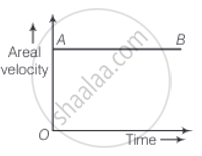Advertisements
Advertisements
प्रश्न
Draw areal velocity versus time graph for mars.
उत्तर
The areal velocity of a planet revolving around the sun is constant with time. Therefore, the graph between areal velocity and time is a straight line (AB) parallel to the time axis. ( Kepler's second law).

APPEARS IN
संबंधित प्रश्न
State Kepler's law of orbit and law of equal areas.
Let the period of revolution of a planet at a distance R from a star be T. Prove that if it was at a distance of 2R from the star, its period of revolution will be \[\sqrt{8}\] T.
The orbit of a planet revolving around a star is _______.
The third law of Kepler is also known as the Law of ______.
To verify Kepler's third law graphically four students plotted graphs. Student A plotted a graph of T (period of revolution of planets) versus r (average distance of planets from the sun) and found the plot is straight line with slope 1.85. Student B plotted a graph of T2 v/s r3 and found the plot is straight line with slope 1.39 and negative Y-intercept. Student C plotted graph of log T v/s log r and found the plot is straight line with slope 1.5. Student D plotted graph of log T v/s log r and found the plot is straight line with slope 0.67 and with negative X-intercept. The correct graph is of student
A planet revolves in an elliptical orbit around the sun. The semi-major and minor axes are a and b, then the time period is given by:
In our solar system, the inter-planetary region has chunks of matter (much smaller in size compared to planets) called asteroids. They ______.
If the sun and the planets carried huge amounts of opposite charges ______.
- all three of Kepler’s laws would still be valid.
- only the third law will be valid.
- the second law will not change.
- the first law will still be valid.
What is the direction of areal velocity of the earth around the sun?
Halley's Comet revolves around the sun for a time period of 76 years. The aphelion distance if perihelion is given by 8.9 × 1010 m, will be ______.
(Take, the mass of sun = 2 × 1030 kg and G = 6.67 × 10-11 Nm3/kg2)
